BY JOHN CARTER JR
Released in February 2009, Coraline is a stop motion family flick by Laika Studios and directed by Henry Selick based on the Neil Gaiman book of the same name. The film tells the story of Coraline Jones (Dakota Fanning), an eleven-year-old who feels disillusioned upon her arrival to her new home, the pink palace apartments. Amidst feeling neglected by her parents, far from her friends and former home, and weirded out by strange neighbors, Coraline begins exploring the old home when she stumbles upon an old door.
This passageway leads her to a parallel world where everything is a “better” version of itself, where everyone is called “Other” before saying their name. On the surface, this world is a beautiful paradise, where anything Coraline wants is hers – but underneath this thin web of perfection is the Other Mother pulling the strings to trap her prey.

This film is among Laika’s best projects and is remembered as being a formative horror family film for the youth of the 2010s. What makes the film so memorable is its beautiful sculpted and stop motion visuals as well as a wonderfully contrasting color palette that convey Coraline’s initial perceptions of both worlds. Moreover, how those aesthetic choices are associated with the mundane and secretly horrifying is excellent. The vocal cast brings life to puppets they are playing with each wholly embodying their character. Keith David’s Cat, Teri Hatcher’s Other Mother, and Jennifer Saunders’ Miss Spink being the standouts of the film.
One fear-instilling aspect of Coraline is in its character design and not just the other world characters. Various characters have spooky or unnerving qualities from a cat with a deep voice giving foreboding warnings, to Wybie wearing a spooky mask and in the other world not being able to speak or Miss Spink’s dead dog collection and even Mr. Bobinsky large gray figure. In the other world, each of the characters not only has creepy button eyes even in their “perfect” forms but also each have a monstrous version of themselves that leads to a gradual building of fear.

The film takes about three cycles of rotating the cast to see this increasing fear and gradual unsettling hints for the audience – making for not only well-paid-off scares but ones that don’t feel unwarranted by that same audience. The first round feature Coraline visiting her neighbors and exploring her new home, whereas the second is filled with lovely distractions by the Other Mother’s Puppets (to which Coraline doesn’t see at first). The final round pays off what the first two trips set up – a gauntlet of wonderfully colorful and horrifying boss fights (Other Bobinsky, Other Spink and Forcible, and Other Father scenes respectively).
Finally, the best and most horrifying aspect of this film was the Other Mother, a character that could haunt the dreams of children and lure them into her spider-like trap. The Other Mother is so unnerving while also having a colorful theme that matches her arachnid and insect aesthetic. Colorful bug underlings, her horrifying body contortions, glow-in-the-dark neon greens, reds, and purples all make for an excellent villain. Her transformation into a slender and dark corrupted version of Coraline’s Mother is excellently executed, being seamless in its animation and scary in its build-up.
She acts as the final boss of sorts for Coraline to get over, this gives the feeling of catharsis to the audience when Coraline escapes her clutches but also leaves them with a remnant of fear knowing that the monster is still somewhere out there.

At the end of the film Coraline takes a new perspective on the world and her new home, and while the problems she had recognized at the beginning of the film still exist she has learned to appreciate the people in her life as they are. She decides to work on the garden with her family and neighbors, bringing everyone together. In doing this, Coraline not only recognizes what she does have and enjoys that but also takes improving her life situation into her own hands. This is felt with the world being lighter and sunny.
These developments convey the maturity and growth the character has achieved through her journey. Coraline is a film about moving forward and recognizing the things in life we take for granted, it’s about the expectation that people have to make up for the faults we see in them rather than addressing the ones in ourselves, and that if we truly want a happier life we have to be willing to address those faults, grow, and change – because a happy life won’t just be handed to you. Life is what you make of it, and you only have one life – another one doesn’t exist on the other side of a door.
I give Coraline a 9/10 hard candy for its horror, its color, and its villain.


